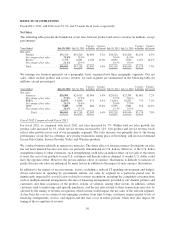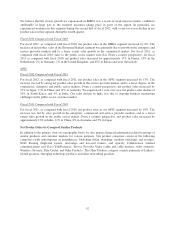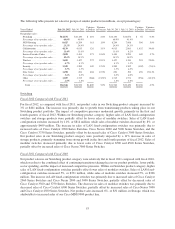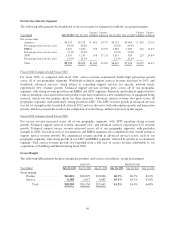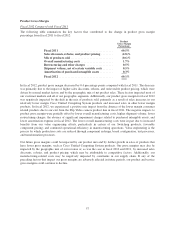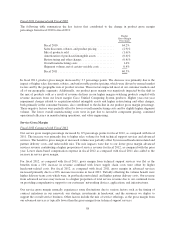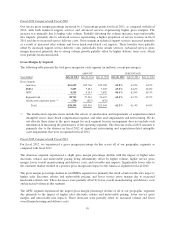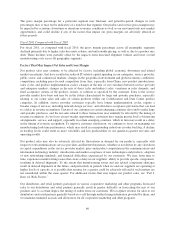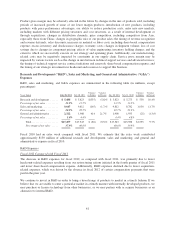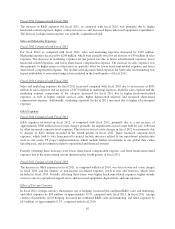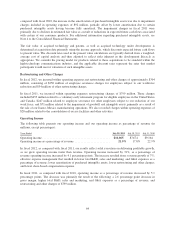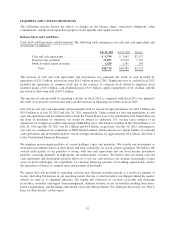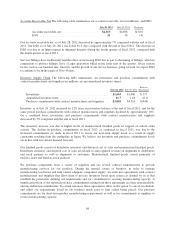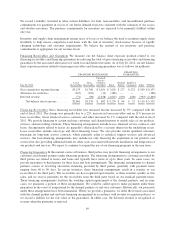Cisco 2012 Annual Report Download - page 68
Download and view the complete annual report
Please find page 68 of the 2012 Cisco annual report below. You can navigate through the pages in the report by either clicking on the pages listed below, or by using the keyword search tool below to find specific information within the annual report.
The gross margin percentage for a particular segment may fluctuate, and period-to-period changes in such
percentages may or may not be indicative of a trend for that segment. Our product and service gross margins may
be impacted by economic downturns or uncertain economic conditions as well as our movement into new market
opportunities, and could decline if any of the factors that impact our gross margins are adversely affected in
future periods.
Fiscal 2011 Compared with Fiscal 2010
For fiscal 2011, as compared with fiscal 2010, the gross margin percentage across all geographic segments
declined primarily due to higher sales discounts, rebates, and unfavorable pricing, as well as due to a product mix
shift. These declines were partially offset by the impacts from increased shipment volume and lower overall
manufacturing costs across all geographic segments.
Factors That May Impact Net Sales and Gross Margin
Net product sales may continue to be affected by factors, including global economic downturns and related
market uncertainty, that have resulted in reduced IT-related capital spending in our enterprise, service provider,
public sector, and commercial markets; changes in the geopolitical environment and global economic conditions;
competition, including price-focused competitors from Asia, especially from China; new product introductions;
sales cycles and product implementation cycles; changes in the mix of our customers between service provider
and enterprise markets; changes in the mix of direct sales and indirect sales; variations in sales channels; and
final acceptance criteria of the product, system, or solution as specified by the customer. Sales to the service
provider market have been and may be in the future characterized by large and sporadic purchases, especially
relating to our router sales and sales of certain products within our Collaboration and Data Center product
categories. In addition, service provider customers typically have longer implementation cycles; require a
broader range of services, including network design services; and often have acceptance provisions that can lead
to a delay in revenue recognition. Certain of our customers in certain emerging countries also tend to make large
and sporadic purchases, and the net sales related to these transactions may similarly be affected by the timing of
revenue recognition. As we focus on new market opportunities, customers may require greater levels of financing
arrangements, service, and support, especially in certain emerging countries, which in turn may result in a delay
in the timing of revenue recognition. To improve customer satisfaction, we continue to focus on managing our
manufacturing lead-time performance, which may result in corresponding reductions in order backlog. A decline
in backlog levels could result in more variability and less predictability in our quarter-to-quarter net sales and
operating results.
Net product sales may also be adversely affected by fluctuations in demand for our products, especially with
respect to telecommunications service providers and Internet businesses, whether or not driven by any slowdown
in capital expenditures in the service provider market; price and product competition in the communications and
information technology industry; introduction and market acceptance of new technologies and products; adoption
of new networking standards; and financial difficulties experienced by our customers. We may, from time to
time, experience manufacturing issues that create a delay in our suppliers’ ability to provide specific components,
resulting in delayed shipments. To the extent that manufacturing issues and any related component shortages
result in delayed shipments in the future, and particularly in periods when we and our suppliers are operating at
higher levels of capacity, it is possible that revenue for a quarter could be adversely affected if such matters are
not remediated within the same quarter. For additional factors that may impact net product sales, see “Part I,
Item 1A. Risk Factors.”
Our distributors and retail partners participate in various cooperative marketing and other programs. Increased
sales to our distributors and retail partners generally result in greater difficulty in forecasting the mix of our
products and, to a certain degree, the timing of orders from our customers. We recognize revenue for sales to our
distributors and retail partners generally based on a sell-through method using information provided by them, and
we maintain estimated accruals and allowances for all cooperative marketing and other programs.
60


